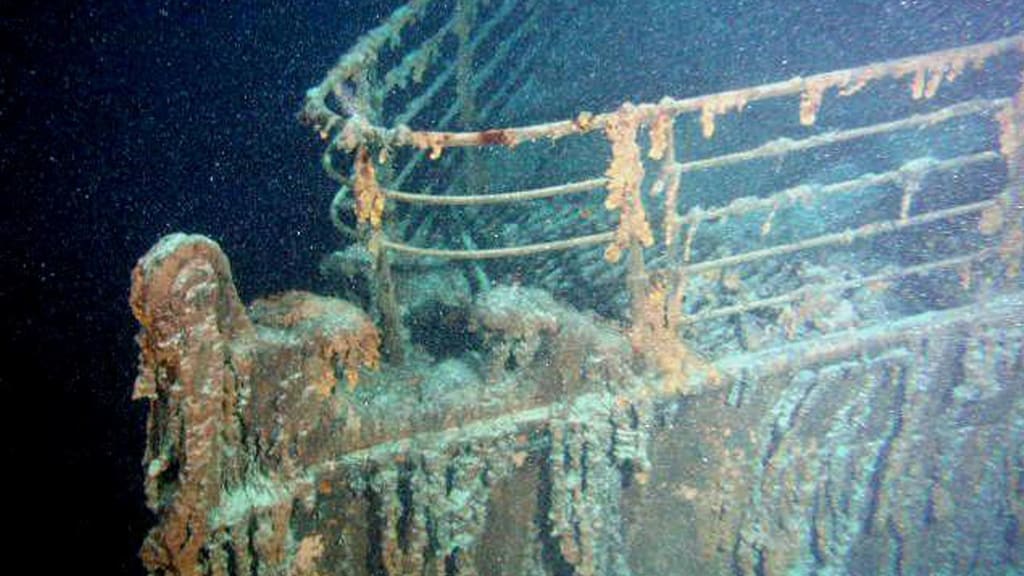Exploring the Titanic Submarine: Unveiling the Depths
Uncovering the Secrets of History's Iconic Tragedy

The Titanic, a name that has become synonymous with tragedy and grandeur, remains one of the most iconic shipwrecks in history. Since its sinking on that fateful night in 1912, the sunken remains of the Titanic have captured the imagination of people worldwide, holding within its depths the untold stories of those who perished. In recent years, a groundbreaking development has emerged to explore and unravel the secrets of this legendary vessel - the Titanic submarine.
The Titanic submarine represents a remarkable feat of engineering and ingenuity, designed specifically for the purpose of exploring the depths and wreckage of the Titanic. It is a vessel that plunges beneath the waves, allowing scientists, historians, and adventurers to reach the site of the disaster and delve into its mysteries like never before. With advanced technologies and a deep passion for uncovering the truth, the Titanic submarine holds the potential to shed new light on this tragic event and rewrite the narratives surrounding it.
The Genesis of the Titanic Submarine:
The birth of the Titanic submarine can be traced back to a deep fascination with the Titanic's tragic history and a burning desire to explore its submerged remains. Over the years, numerous expeditions had been conducted to the site, but the vast depths and challenging conditions posed significant obstacles to comprehensive exploration.
Driven by technological advancements and a shared passion for uncovering the mysteries of the Titanic, a collaborative effort between scientists, engineers, and historians was initiated to develop a specialized submarine capable of navigating the depths and exploring the wreckage. The project brought together experts from various fields, including marine engineering, robotics, imaging technology, and underwater archaeology.
The Titanic submarine's development required a combination of innovation, cutting-edge technology, and meticulous planning. Advanced materials were employed to construct a vessel that could withstand the immense pressure and corrosive nature of the deep-sea environment. The submarine's design prioritized both durability and maneuverability, ensuring it could navigate the complex terrain of the Titanic wreckage.
Significant progress in imaging and sonar technologies played a pivotal role in the creation of the Titanic submarine. State-of-the-art sonar systems were integrated to map the ocean floor with remarkable precision, enabling scientists to identify potential target areas for exploration. High-resolution imaging devices were incorporated to capture detailed photographs and videos of the wreckage, providing valuable visual documentation.
The development of the Titanic submarine was not without its challenges. Engineers had to contend with the extreme conditions of the deep sea, including frigid temperatures, immense water pressure, and limited visibility. Safety measures were meticulously engineered, including redundant systems and fail-safes, to ensure the well-being of the crew and the preservation of the valuable data collected.
Ultimately, the genesis of the Titanic submarine represents a convergence of technology, expertise, and a shared passion for unraveling the secrets of the Titanic. It embodies the culmination of years of research, dedication, and perseverance to create a vessel capable of reaching the depths and shedding new light on one of history's most captivating tragedies. With the launch of the Titanic submarine, the stage was set for an unprecedented journey to the heart of the Titanic's resting place, where new chapters in its story would be unveiled.
Design and Features of the Titanic Submarine:
The Titanic submarine is a remarkable engineering achievement, purpose-built to withstand the extreme conditions of the deep-sea environment and effectively explore the wreckage of the Titanic. Designed with meticulous attention to detail, the submarine incorporates several key features and cutting-edge technologies.
1. Structural Integrity: The submarine's construction prioritizes robustness and durability. It is made from high-strength materials, such as titanium alloys and reinforced composites, capable of withstanding the immense water pressure at great depths. The hull design incorporates spherical and cylindrical sections, providing both strength and stability.
2. Navigation and Maneuverability: Navigating the complex underwater terrain of the Titanic wreckage requires precise control and maneuverability. The submarine is equipped with advanced thruster systems that enable it to move with agility, facilitating exploration and avoiding potential obstacles.
3. Life Support Systems: The submarine ensures the safety and well-being of its crew through comprehensive life support systems. These systems include provisions for breathable air, temperature control, and waste management. The crew compartment is designed to provide a comfortable and habitable environment during extended underwater expeditions.
4. Imaging and Sonar Technologies: Advanced imaging and sonar technologies are integrated into the submarine to facilitate detailed mapping and documentation of the Titanic wreckage. High-resolution cameras and video equipment capture clear visuals of the site, while sonar systems create three-dimensional maps of the ocean floor, aiding in navigation and identifying points of interest.
5. Remote Operated Vehicles (ROVs): The Titanic submarine is often equipped with remotely operated vehicles, or ROVs, that can be deployed to access hard-to-reach areas of the wreckage. These ROVs are equipped with manipulator arms and specialized tools to collect samples, retrieve artifacts, and perform delicate tasks while being controlled from the safety of the submarine.
6. Data Collection and Analysis: The submarine houses an array of scientific instruments for data collection and analysis. These instruments may include sensors for measuring water properties, analyzing sediment composition, and detecting chemical signatures. The collected data provides valuable insights into the environment surrounding the wreck and aids in understanding the processes affecting its preservation.
7. Communication and Data Transmission: The submarine is equipped with advanced communication systems that enable real-time communication with the surface support team. This allows for seamless coordination between the crew and support personnel, ensuring efficient exploration and maximizing the utilization of resources.
The design and features of the Titanic submarine represent a fusion of engineering expertise and technological innovation. This purpose-built vessel empowers scientists, historians, and explorers to navigate the depths and unravel the mysteries that lie within the Titanic wreckage. With its robust construction, state-of-the-art imaging capabilities, and advanced systems, the Titanic submarine stands as a testament to human ingenuity and our relentless quest for knowledge.
Exploring the Titanic Wreckage:
The Titanic submarine embarks on a remarkable journey into the depths of the ocean, reaching the site where the Titanic's remains lie undisturbed. The exploration of the Titanic wreckage is a complex and challenging endeavor, requiring careful planning, technical expertise, and a deep understanding of the underwater environment.
1. Descent to the Wreck Site: The journey begins with the descent of the Titanic submarine to the depths where the shipwreck rests. The crew navigates through the dark and cold waters, gradually descending to the precise location of the wreckage. This phase demands careful navigation to avoid potential hazards and ensure the safety of the crew and equipment.
2. Mapping and Documentation: Once the submarine reaches the Titanic wreckage, it utilizes advanced imaging and sonar technologies to map and document the site in meticulous detail. High-resolution cameras and video equipment capture images and footage, revealing the decaying remnants of the ship. Sonar systems create detailed three-dimensional maps, providing a comprehensive understanding of the wreck's layout and topography.
3. Artifact Recovery and Sampling: The Titanic submarine often utilizes remotely operated vehicles (ROVs) to access hard-to-reach areas of the wreckage. Equipped with manipulator arms and specialized tools, these ROVs collect artifacts, retrieve samples, and document specific details of interest. These recovered artifacts and samples contribute to the broader understanding of the ship's construction, personal belongings, and historical context.
4. Scientific Investigations: The exploration of the Titanic wreckage extends beyond visual documentation. Scientists onboard the submarine utilize a range of scientific instruments to gather valuable data about the wreck and its surrounding environment. Water properties, sediment composition, and chemical signatures are analyzed to study the degradation processes, ecosystem interactions, and preservation challenges.
5. Human Stories and Remembrance: Alongside the scientific investigations, the Titanic submarine plays a crucial role in honoring the human stories associated with the tragedy. The exploration captures the imaginations of people worldwide, bringing to light the personal artifacts, structural remains, and poignant reminders of the lives lost on that ill-fated voyage. By documenting and preserving these details, the submarine helps ensure the memory of those who perished remains alive.
Throughout the exploration of the Titanic wreckage, the submarine operates in a methodical and meticulous manner, carefully documenting each discovery and maintaining a strong focus on conservation efforts. The data collected during these expeditions provides invaluable insights into the Titanic's construction, the events leading to its sinking, and the human impact of this historic disaster.
The exploration of the Titanic wreckage represents an ongoing endeavor, with each expedition uncovering new details and deepening our understanding of this tragic event. By venturing into the depths and bringing the Titanic's story to the surface, the Titanic submarine enables us to connect with history in a profound and meaningful way.
Discoveries and Contributions:
The expeditions conducted by the Titanic submarine have yielded significant discoveries, shedding new light on the Titanic's tragic story and making invaluable contributions to our understanding of this historic event. These discoveries have provided insights into various aspects of the ship, its passengers, and the circumstances surrounding its sinking.
1. Ship's Construction and Damage Patterns: Through detailed imaging and examination of the wreckage, the Titanic submarine has contributed to a better understanding of the ship's construction and the impact of the iceberg collision. By analyzing the damage patterns, scientists and historians have gained insights into the vulnerabilities of the vessel and how it succumbed to the forces of the sea.
2. Artifact Recovery and Preservation: The recovery of artifacts from the Titanic wreckage has been a poignant aspect of the submarine's expeditions. By carefully retrieving personal belongings, household items, and other objects from the site, the submarine has helped preserve the memory of the individuals onboard and offered glimpses into their lives before the disaster. These artifacts provide a tangible connection to the past and contribute to the historical narrative surrounding the Titanic.
3. Unraveling Human Stories: The Titanic submarine's exploration has contributed to unraveling the human stories associated with the tragedy. By documenting the personal effects found in the wreckage, such as letters, photographs, and personal items, the submarine helps piece together the lives and experiences of the passengers and crew. These stories humanize the event and provide a poignant reminder of the human cost of the Titanic's sinking.
4. Scientific Research and Preservation Efforts: The expeditions of the Titanic submarine have contributed to scientific research focused on the preservation of the wreckage and the surrounding marine environment. By studying the degradation processes, ecosystem interactions, and the impact of human activities on the wreck site, scientists can develop strategies for sustainable conservation. This knowledge aids in preserving the Titanic's remains for future generations and fostering a greater understanding of the delicate balance between exploration and preservation.
5. Public Engagement and Education: The discoveries made by the Titanic submarine have captivated the public's imagination and created a renewed interest in the Titanic's story. The submarine's expeditions have been extensively documented and shared through various media channels, bringing the exploration and its findings to a global audience. This heightened public awareness fosters a greater appreciation for maritime history and the importance of preserving these cultural heritage sites.
Future Implications and Conservation Efforts:
The expeditions conducted by the Titanic submarine have far-reaching implications for both the future of exploration and the ongoing conservation of the Titanic wreckage. As technology continues to advance and our understanding of underwater archaeology deepens, these implications become increasingly significant.
1. Continued Exploration and Discovery: The success of the Titanic submarine in uncovering new insights about the Titanic encourages further exploration of other shipwrecks and underwater archaeological sites. The technologies and methodologies developed for the Titanic submarine can be applied to other maritime mysteries, expanding our knowledge of the past and unraveling additional stories hidden beneath the waves.
2. Advancements in Imaging and Sensing Technologies: The exploration of the Titanic wreckage has pushed the boundaries of imaging and sensing technologies. The innovations developed for the submarine's expeditions have broader applications in underwater exploration, including environmental monitoring, geophysical surveys, and the study of marine ecosystems. These advancements have the potential to revolutionize how we explore and understand our oceans.
3. Balancing Exploration and Preservation: The expeditions of the Titanic submarine highlight the delicate balance between exploration and the preservation of historical sites. As interest in underwater archaeology grows, it is crucial to establish ethical guidelines and conservation practices to protect these sites from further damage. The knowledge gained from the Titanic submarine's expeditions can inform future conservation efforts, ensuring that these cultural heritage sites are preserved for future generations.
4. Public Engagement and Education: The exploration of the Titanic wreckage captivates the public's imagination and provides a platform for educating people about maritime history, preservation, and the importance of environmental stewardship. The discoveries made by the Titanic submarine serve as powerful educational tools, fostering a deeper understanding of the past and inspiring future generations to become stewards of our oceans and their rich history.
5. Sustainable Tourism and Economic Impact: The Titanic submarine's expeditions also have implications for sustainable tourism and local economies. By promoting responsible tourism practices and raising awareness about the historical and ecological significance of sites like the Titanic wreckage, communities can benefit economically while ensuring the long-term preservation of these underwater treasures.
The Titanic submarine has revolutionized underwater exploration, uncovering the secrets of the iconic Titanic wreckage. Its technological advancements and discoveries have deepened our understanding of the ship's construction, human stories, and the delicate balance between exploration and preservation. The expeditions have engaged the public, inspired education, and paved the way for future advancements in technology and sustainable tourism. The legacy of the Titanic submarine connects us to history and emphasizes the importance of preserving underwater cultural heritage. It continues to unveil new chapters in the Titanic's story, urging us to explore, learn, and honor the lives lost.
About the Creator
Enjoyed the story? Support the Creator.
Subscribe for free to receive all their stories in your feed. You could also pledge your support or give them a one-off tip, letting them know you appreciate their work.






Comments
There are no comments for this story
Be the first to respond and start the conversation.